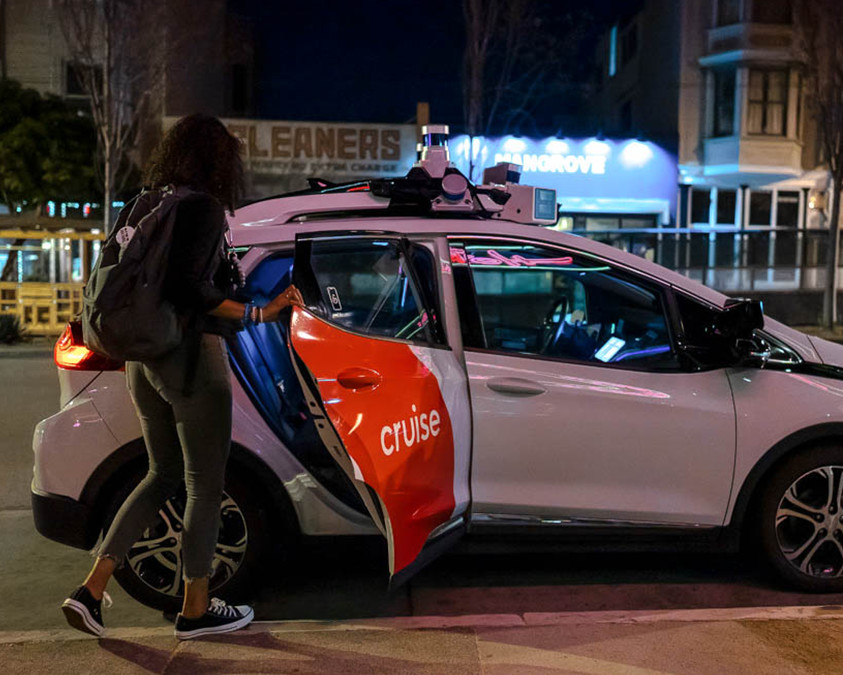Self-driving cars have met their match in the form of the humble traffic cone.
If you’re on TikTok, you may have seen what I’m talking about: a viral video of San Francisco activists disabling autonomous Cruise and Waymo vehicles by placing bright orange traffic cones on their hoods.
The cones immobilize the autonomous vehicles by forcing them into “shutdown mode” with their hazard lights on, “until the cone is removed or a company technician comes to reset the car’s system,” the San Francisco Standard reported. Safe Street Rebel, the group behind the stunt, unleashed the cones last week ahead of a vote scheduled for Thursday by the California Public Utilities Commission that could allow Cruise and Waymo robotaxis unimpeded access to public streets in the city as the next phase of their development. Right now, Cruise (which is owned by General Motors) and Waymo (part of Alphabet, né Google) are offering limited service in San Francisco—a trial rollout that has caused enough actual chaos in the city to justify locals’ mistrust. “We want to either have [autonomous vehicles] not on the city streets at all or very limited,” one Rebel told the Standard. “It’s like the state has decided that these things are going to be deployed in San Francisco without the consent of the city or the people in it.”
Speaking to the Standard, an unnamed Waymo spokesperson called the coning “vandalism” that “encourages unsafe and disrespectful behavior on our roadways.” Hannah Lindow, a Cruise spokesperson who at least attached her name to her statement, told the publication that “intentionally obstructing vehicles gets in the way of those efforts and risks creating traffic congestion for local residents.” The SFMTA, San Francisco’s municipal transportation agency, said on Twitter on Friday that it “does not endorse ANY actions that may increase the number of disabled AVs on San Francisco streets,” and encouraged people to attend this week’s CPUC meeting.
[…]
There is a long tradition in urbanism of residents taking matters into their own hands when they feel abandoned by local authorities. It is known variously as tactical, do-it-yourself, pop-up, and even guerrilla urbanism. Examples of tactical urbanism include turning dumpsters into swimming pools, reclaiming parking spots as tiny parks, and painting crosswalks on neglected intersections. These interventions have been described as playful, innovative, and spontaneous. They are typically low-budget and executed by volunteers or activists. All are by definition unsanctioned.
Using traffic cones to disarm a driverless car is textbook tactical urbanism: an intervention by concerned local activists in response to perceived neglect and inaction by local authorities. It’s also brilliant. I challenge you to find a more powerful image of people protesting technology in the recent past than that of the humble orange traffic cone perched atop an inert driverless car. There is the obvious metaphor (a Silicon Valley unicorn, rendered literal and impotent), the terrific color and contrast, the clear juxtaposition of power and wealth with human ingenuity. The financials, should you pause to consider them, are mind-blowing. You can buy a dozen heavy-duty traffic cones on Amazon for about $250, or about $21 per cone. You can use that $21 object to incapacitate a machine that has so far cost many billions of dollars to develop, and will surely consume many billions more.
As noted before, these cars got onto the streets in San Francisco without a lot of regulatory oversight, which has caused some amount of chaos. Cruise cars are now in Austin and Houston, though I’ve only seen them at public charging stations. They’re just now being deployed to carry passengers in Austin, so we’re likely still a bit out from seeing them in production here. The point of the stunt in San Francisco was to raise awareness of a state regulator meeting at which these cars would be discussed. I wish these activists well in their pursuit of having their concerns heeded. Whether anyone will try something similar here, that remains to be seen.

